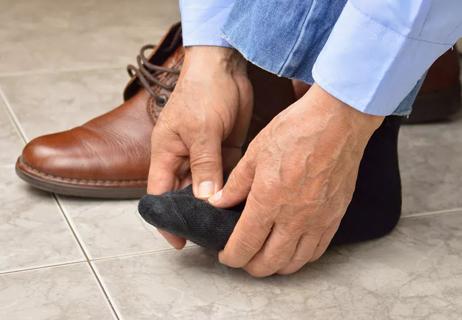One thing is for sure: This footwear definitely kicks up controversy

Some people prefer shoes that truly fit like a glove.
Advertisement
Cleveland Clinic is a non-profit academic medical center. Advertising on our site helps support our mission. We do not endorse non-Cleveland Clinic products or services. Policy
A group within the minimalist shoe movement swears by odd-looking footwear featuring separate slots for each toe. These so-called “gloves for your feet” are meant to mimic going barefoot, encouraging a more natural movement as you run or walk.
The simplistic gear lacks the cushioning and arch support found in more traditional shoes. Why? Well, the idea is that a stripped-down shoe strengthens your foot muscles, ligaments and tendons, which helps reduce your risk of chronic injuries.
In truth, the concept has some validity … but the theory isn’t all that sure-footed, either. Let’s walk through the arguments for and against toe shoes with podiatrist Nicole Nicolosi, DPM.
For starters, they’re a bit controversial. They exploded on the running scene a little more than a decade ago before seeing sales drop amidst lawsuits questioning the veracity of all those good-for-your-feet health claims.
In 2011, the U.S. Army even banned soldiers from wearing toe shoes while training with this edict: “Only those shoes that accommodate all five toes in one compartment are authorized for wear.”
A niche market for the glove-like footwear remains. There have even been signs of toe shoes becoming somewhat of a haute couture fashion item.
Advertisement
Overall, running and athletic-focused toe shoes are noted for being:
The answer to that question isn’t exactly clear-cut. “These minimalist-type shoes are good in certain respects and negative in others,” says Dr. Nicolosi. “That being said, they’re definitely not for everyone.”
So, let’s look at the potential advantages and disadvantages, as well as who might want to consider adding toe shoes to their closet.
The argument for toe shoes begins with strength-building. One study found that runners and walkers who wear toe shoes increase muscle thickness in their feet, which can help stabilize their arches.
Supportive shoes, on the other hand, don’t work those foot muscles quite as hard because they’re offering support. Over the long term, that may contribute to a gradual flattening of the arches.
“One of the main selling points of minimalist or toe shoes is that they’re meant to reduce stress injuries that could come from wearing more of a structural or restricted shoe,” says Dr. Nicolosi.
Toe shoes also may:
As explained above, the “good” thing about toe shoes centers on their lack of extra support for your feet. The “bad” thing? It’s exactly the same thing. (As we said, this topic tends to stir up some debate.)
“With this lack of support, you’re predisposing the foot into other mechanical conditions that can lead to problems,” states Dr. Nicolosi.
Concerns include:
There may be a place for toe shoes on your shoe rack if they’re used in moderation. If you’re a runner or distance walker, for instance, a trek in the shoes could be viewed as a cross-training variation to your routine.
“A minimalist type of shoe could be beneficial for an experienced runner or active walker who wants to take it to the next level,” notes Dr. Nicolosi.
Just be careful not to do too much too soon while wearing the shoes. Give your feet time to adjust to wearing shoes that offer less support, as it will be more taxing on some muscles, joints and tendons.
Advertisement
Overall, though, Dr. Nicolosi suggests that you’re probably better off sticking with your tried-and-true footwear. “I’m more in the camp of giving your feet some support,” she says.
In other words, keep “gloves” as a hands-only item.
Advertisement
Learn more about our editorial process.
Advertisement

Except in certain medical scenarios, foot health experts rarely recommend foot soaks

The years can literally reshape your feet

Most recommended precautions center around minimizing bruising or swelling

Even one drink can have an impact on your cognitive function leading to slurred speech, blurred vision and impaired memory

Understand who may (and may not) benefit

Lorem ipsum dolor sit amet. Et odio Quis vel ipsam omnis eum alias deleniti et placeat impedit non voluptas galisum hic autem enim et cupiditate aliquid. Est beatae quidem non facilis autem ut commodi nisi aut tempore rerum et dolores voluptatem cum enim optio id sapiente quasi. Ad laboriosam officiis 33 cupiditate sequi ea voluptatum consectetur qui necessitatibus voluptate et quasi doloremque et facere explicabo quo explicabo officia

Type 2 diabetes isn’t inevitable with these dietary changes

Applying a hot or cold compress can help with pain